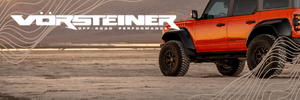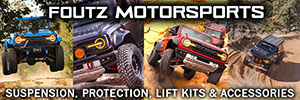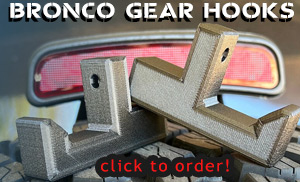I'm starting here with a summary of measurement information on the stock Bronco Raptor as I couldn't find these answers anywhere:
Safety Note: I never ever go under my vehicles when the tires removed. If I'm working under the vehicle I prefer to use Ramps if possible rather than jack stands as shown here in another thread Elevating for ease of Service.
There is probably better jacking solutions, but this is my first economical attempt with lifting the Bronco Raptor to rotate the tires or hub/brake maintenance.
With my other solid axle 4x4's the task to jack them up is pretty easy under the axles. However I've been pondering how do I safely jack up the Bronco Raptor front with its long travel independant front suspension in my home garage. Ford recommends jacking on the frame bottom, not the lower control arms, so I ordered 4 of these UniJacks along with mating rubber saddles. I liked that these UniJacks is one point of contact vs using a floor jack and jackstands, and the large flat stand base which should be kind to flooring like Racedeck or Swisstrax. The box lists the lifting range is 11"-21" which seemed like 10" of frame lift would be a good initial guess.
Amazon link for UniJack
Amazon link for mating rubber saddles


However, once I unboxed these UniJacks I realized they do Not have a 10" lift range due to it's adjustable saddle, instead it's approximately 5", and the box should read lowest lift range of 11"-16" and highest lift range of 16.5"-21.5". My fault for not studying the UniJack design and operation prior to purchasing. I still managed to get the BR fully lifted using the combination of the 4 UniJacks on the frame, but required more work that I had planned. I jacked the front up, then rear, then back to the front to add the wooden blocks under the UniJacks and this was possible because the front tires had dropped and swung inward so when the jack was released the front doesn't drop to the starting height. I then still needed to raise the rear axle with a floor jack to place a couple extra 3 ton jack stands under the axle in order to get the rear tires off the floor.
Note that in all the below photo's, the jackstand portion of the UniJack is locked into position and bottle jack portion pump valve has been released.

This measurement to the Flare is after the tire is off the floor, started at ~43 inches.

Jack below isn't bent, just play in the jackstand adjuster. Note from the floor to the bottom of frame at this front lift point is 24 inches.


Floor to the frame at this rear lift point as shown is 24.5 inches. The rear tires were still on the floor, so I jacked the rear diff up with a floor jack and added the two 3 ton jackstands to support the rear axle enough to get the rear tires off the floor without jacking the entire Bronco Raptor any higher. I ran out of 2x12 blocks so I compromised with some King Starboard strips.

Below measurement is 23.5 inches once elevated from floor to front frame crossmember (Bash & engine skid plates removed). Added here just for documentation.

If I should find a better jacking solution I will post here in this thread. I have other vehicles I can use the UniJacks on for storage.
The ideal UniJack for our Bronco Raptors in stock form would be able to raise continuously from 13.75" to 24.5" and lock into place.
These Quick Jacks would be a good solution, but at 2k I would go ahead and get a 4 post lift.
- Bottom of frame at Jack points on stock Bronco Raptor: Front ~14 inches, Rear ~14.5 inches
- Front tire drop will be 5-5.5 inches (will vary slightly for each BR, especially if additional weight added to front)
- Frame needs raised ~10 inches to be able to remove front tires provided tires are fully inflated (42 psi), add to the 10" if needed for tire squat due to underinflated tire.
- Frame needs to be at 24" from floor for front tires (stock 37") to be off the floor.
- Front fender flare lip at centerline of tire is 49.25 inches from the floor.
- Front Frame crossmember that front suspension lower A frame attaches to is 23.5" above floor to have full drop (stock 37" tires off the floor).
- Never accomplished full rear axle drop as I used jackstands under the rear axle due to wanting to keep the Bronco Raptor level while not raising any further than needed.
There is probably better jacking solutions, but this is my first economical attempt with lifting the Bronco Raptor to rotate the tires or hub/brake maintenance.
With my other solid axle 4x4's the task to jack them up is pretty easy under the axles. However I've been pondering how do I safely jack up the Bronco Raptor front with its long travel independant front suspension in my home garage. Ford recommends jacking on the frame bottom, not the lower control arms, so I ordered 4 of these UniJacks along with mating rubber saddles. I liked that these UniJacks is one point of contact vs using a floor jack and jackstands, and the large flat stand base which should be kind to flooring like Racedeck or Swisstrax. The box lists the lifting range is 11"-21" which seemed like 10" of frame lift would be a good initial guess.
Amazon link for UniJack
Amazon link for mating rubber saddles
However, once I unboxed these UniJacks I realized they do Not have a 10" lift range due to it's adjustable saddle, instead it's approximately 5", and the box should read lowest lift range of 11"-16" and highest lift range of 16.5"-21.5". My fault for not studying the UniJack design and operation prior to purchasing. I still managed to get the BR fully lifted using the combination of the 4 UniJacks on the frame, but required more work that I had planned. I jacked the front up, then rear, then back to the front to add the wooden blocks under the UniJacks and this was possible because the front tires had dropped and swung inward so when the jack was released the front doesn't drop to the starting height. I then still needed to raise the rear axle with a floor jack to place a couple extra 3 ton jack stands under the axle in order to get the rear tires off the floor.
Note that in all the below photo's, the jackstand portion of the UniJack is locked into position and bottle jack portion pump valve has been released.
This measurement to the Flare is after the tire is off the floor, started at ~43 inches.
Jack below isn't bent, just play in the jackstand adjuster. Note from the floor to the bottom of frame at this front lift point is 24 inches.
Floor to the frame at this rear lift point as shown is 24.5 inches. The rear tires were still on the floor, so I jacked the rear diff up with a floor jack and added the two 3 ton jackstands to support the rear axle enough to get the rear tires off the floor without jacking the entire Bronco Raptor any higher. I ran out of 2x12 blocks so I compromised with some King Starboard strips.
Below measurement is 23.5 inches once elevated from floor to front frame crossmember (Bash & engine skid plates removed). Added here just for documentation.
If I should find a better jacking solution I will post here in this thread. I have other vehicles I can use the UniJacks on for storage.
The ideal UniJack for our Bronco Raptors in stock form would be able to raise continuously from 13.75" to 24.5" and lock into place.
These Quick Jacks would be a good solution, but at 2k I would go ahead and get a 4 post lift.








